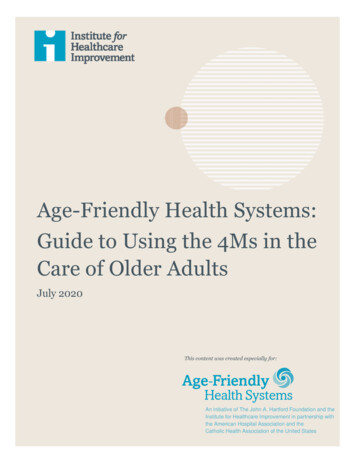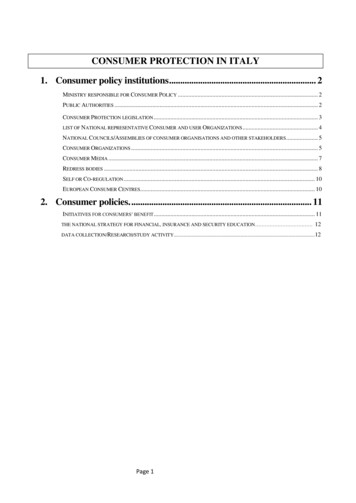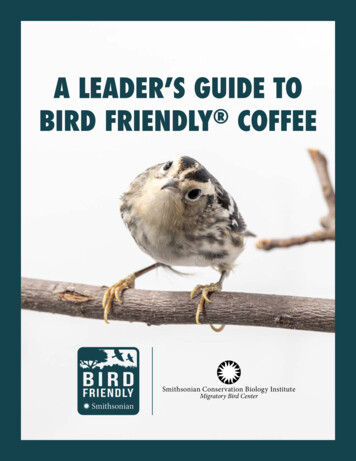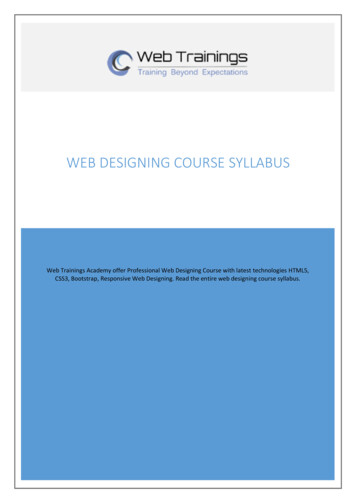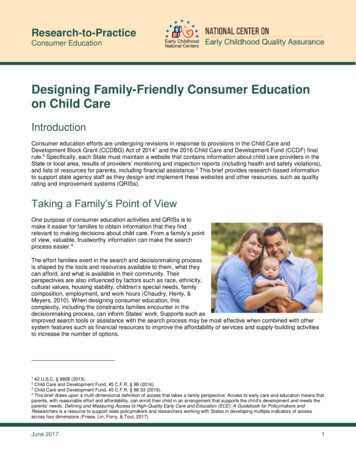
Transcription
Research-to-PracticeConsumer EducationDesigning Family-Friendly Consumer Educationon Child CareIntroductionConsumer education efforts are undergoing revisions in response to provisions in the Child Care andDevelopment Block Grant (CCDBG) Act of 2014 1 and the 2016 Child Care and Development Fund (CCDF) finalrule.2 Specifically, each State must maintain a website that contains information about child care providers in theState or local area, results of providers’ monitoring and inspection reports (including health and safety violations),and lists of resources for parents, including financial assistance. 3 This brief provides research-based informationto support state agency staff as they design and implement these websites and other resources, such as qualityrating and improvement systems (QRISs).Taking a Family’s Point of ViewOne purpose of consumer education activities and QRISs is tomake it easier for families to obtain information that they findrelevant to making decisions about child care. From a family’s pointof view, valuable, trustworthy information can make the searchprocess easier.4The effort families exert in the search and decisionmaking processis shaped by the tools and resources available to them, what theycan afford, and what is available in their community. Theirperspectives are also influenced by factors such as race, ethnicity,cultural values, housing stability, children’s special needs, familycomposition, employment, and work hours (Chaudry, Henly, &Meyers, 2010). When designing consumer education, thiscomplexity, including the constraints families encounter in thedecisionmaking process, can inform States’ work. Supports such asimproved search tools or assistance with the search process may be most effective when combined with othersystem features such as financial resources to improve the affordability of services and supply-building activitiesto increase the number of options.142 U.S.C. § 9858 (2015).Child Care and Development Fund, 45 C.F.R. § 98 (2016).3Child Care and Development Fund, 45 C.F.R. § 98.33 (2016).4This brief draws upon a multi-dimensional definition of access that takes a family perspective: Access to early care and education means thatparents, with reasonable effort and affordability, can enroll their child in an arrangement that supports the chil d’s development and meets theparents’ needs. Defining and Measuring Access to High-Quality Early Care and Education (ECE): A Guidebook for Policymakers andResearchers is a resource to support state policymakers and researchers working with States in developing multiple indicators of accessacross four dimensions (Friese, Lin, Forry, & Tout, 2017).2June 20171
Designing Family-Friendly Consumer EducationResearch on Decisionmaking about Child CareResearch findings about how families navigate the process of finding child care arrangements offer a helpfulsource of information for designing consumer education activities in general and as a component of a QRIS. Thefindings provide general considerations that States can use to inform goal setting and planning. At the same time,the findings do not represent every racial, ethnic, or cultural group, nor are they representative of the geographyof the country. When possible, we encourage additional data collection at the state and local levels to promote agreater awareness of families’ unique needs and perceptions. In this brief, we seek to provide meaningfulinformation that will allow state leaders to understand general applicability of the findings while acknowledgingthat multiple approaches are needed to address families’ diverse needs. We explore three key questions: Why do families search for early care and education? How do families search for early care and education? What features do families look for in early care and education settings?Each key question is followed by a discussion of its implications for state work to support consumer education.A variety of research studies inform this brief, including findings from the National Survey of Early Care andEducation (NSECE) and links to the original NSECE research papers. The NSECE is a nationally representativestudy conducted in 2012 that includes a significant survey of households with children younger than 13 (inaddition to surveys of the center-based and home-based workforce). When possible, this brief provides NSECEdata for families that differ by income level and race and ethnicity.Question 1. Why Do Families Search for Early Care and Education? Employment and supporting children’s social-emotional development are the two primary reasonsfamilies search for early care and education (ECE). According to the NSECE (2014), employment is themain reason for child care searches, regardless of household income. Children’s educational and socialenrichment is the second reason across all household income levels. Nearly half (49 percent) of families withincome at or below 100 percent of the federal poverty level cited work as their primary reason for searchingfor ECE, compared with 36 percent of families in the highest income bracket (at or above 300 percent of thefederal poverty level). There are few differences in search reasons by race and ethnicity. Primary reasons for child care search vary by child’s age. According to the NSECE (2014), the majorityof families searching for ECE for infants and toddlers (51 percent) do so primarily for work-related reasons. Incomparison, only 28 percent of families searching for ECE for a preschool-age child do so primarily for workrelated reasons, with 41 percent searching primarily to support their child’s educational and social needs.Design ConsiderationsThe reason families initiate a search for ECE and their family context (for example, their child’s age) may shapethe timing and urgency of their search. Written materials or website text could address these different reasonsand the particular needs families may have.For example, web links specific to different family circumstances could provide an entry portal through whichfamilies begin their searches. This option is in contrast to beginning a search by address or by program type.Based on what we learn from the NSECE, options for text might include the following: “Are you changing jobs?”;“Are you looking for the best educational and social child care or preschool for your preschool child?”; and “Areyou looking for child care for your baby or toddler?” Families could be directed to a page with information tailoredto their needs (for example, a page with details about the features of care that are important for infants andJune 20172
Designing Family-Friendly Consumer Educationtoddlers), as well as links to a search tool with filters such as child care quality, hours of services, type of care,and availability of transportation.Question 2. How Do Families Search for Early Care and Education? The majority of families (63 percent), regardless of income, consider more than one child care provider andmake a choice based on information received from family and friends (NSECE Project Team, 2014). The nextmost commonly used source of information is the Internet, with more than one-third (39 percent) of familiesreporting that they make their decisions using web-based information (NSECE Project Team, 2014).According to the NSECE, the majority of families who considered more than one child care provider made achoice based on information received from family members and friends. Similarly, though specifics vary bystudy, other state, multistate, and local research studies have consistently found that most families with lowincomes learn about child care providers from friends, family members, and neighbors (Forry, Tout,Rothenberg, Sandstrom, & Vesely, 2013). More than a third of families consider only one childcare provider as part of their child care search; 71percent of these households have a previousrelationship with that provider. According to the NSECE(2014), considering only one provider is slightly morecommon among families searching for care for a youngchild (0 to 36 months, 74 percent) than an olderpreschooler (36 to 60 months; 68 percent). A literaturereview reported that most low-income parents perceivehaving limited child care options and consider only one ortwo options in their search (Forry, Tout, et al., 2013). On average, families with low incomes make child care decisions quickly. In one study of familieseligible for child care subsidies in Maryland, 41 percent of parents made choices within one day (Forry,Simkin, Wheeler, & Bock, 2013). In another study of families eligible for subsidies in Minnesota, 82 percent ofparents surveyed choose their ECE arrangement within two weeks (Forry, Isner, Daneri, & Tout, 2014). Quickdecisions are not necessarily related to parental satisfaction with care. Parents may need to make child caredecisions quickly to meet job training or employment requirements or to keep their subsidy benefits or theirjob if their child care arrangements are interrupted (Weber, 2011). Families report gathering information on cost and operating hours as well as program content andcurriculum. Among all families with children under 5 that considered more than one child care option, themost frequently cited information that families gathered about the program includes fees charged (39percent), type of care (36 percent), hours of care (35 percent), content of the program (26 percent), andcurriculum or philosophy of the program (18 percent) (NSECE Project Team, 2014). However, there arevariations by child age, household poverty status, and community poverty, as discussed below. Information gathered about ECE varies by child age, household poverty status, and communitypoverty. According to the NSECE (2014), families searching for ECE for infants and toddlers (0 to 36months) are more likely to collect information on fees charged and hours of care, and parents searching forECE for preschool-aged children (36 to 60 months) are more likely to collect information on the content ofthe program and the curriculum or philosophy. Compared with families in low-poverty communities, 5 fewerfamilies in high-poverty communities consider fees (though more consider availability of financial aid), type ofcare, and content of the program. These findings may reflect a lack of supply in high-poverty communities.5Low-poverty communities and high-poverty communities are defined in the NSECE using guidelines from the U.S. Census Bureau. Lowpoverty density is 0–13.8 percent of households under the federal poverty level. High poverty density is more than 20 percent of householdsunder the federal poverty level. There is no additional information available at this time on information gathering by families broken out by raceand ethnicity.June 20173
Designing Family-Friendly Consumer Education Almost half (42 percent) of the time, ECE searches do not lead to a new arrangement. Additionally,families from the NSECE (2014) that considered only one ECE provider as part of their search are more likelyto change providers than those that considered multiple providers (66 percent versus 54 percent). Familiessearching for a preschool-aged child’s care are more likely to change providers than those searching for atoddler’s care (65 percent versus 54 percent).Design ConsiderationsReferrals from family and friends are influential. Web-based search tools and other written information for familiescould build on these relationship-based factors by promoting sharing of information about ECE via text or socialmedia. For example, web links could encourage families to share the web-based search tools they used, alongwith what they decided to do. Texas’s website includes links to Facebook, Twitter, Pinterest, and others. It also tracks the number of timesthat the page has been shared(http://www.dfps.state.tx.us/Child Care/Search Texas Child Care/ppFacilitySearchDayCare.asp).Families consider fees charged, type of care, hours of care, content of the program, and curriculum or philosophyof the program as top features when they search. Default settings on a website should be carefully planned sothat this information is easily accessible. Several States have an option to narrow the child care search by thelanguages spoken by the child care provider. The default setting for search results in some States list programsby QRIS level to encourage emphasis on program quality.Question 3. What Features Do Families Look for in Child CareSettings? In general, families place a high value on the quality ofchild care arrangements, but their definitions of qualityand aspects of quality they prioritize vary. In addition,having fewer choices for child care because of factors suchas neighborhood supply or cost limits a family's ability toprioritize quality. Across studies, families’ definitions of highquality care tend to include both structural features (e.g.,provider education, training, and child-adult ratio) andprocess-oriented features (e.g., health and safety, providerwarmth, emotional tone of the setting, activities to supportchild development, and open communication with the family)(Forry, Tout, et al., 2013). Cost, location, and hours are highly influential in parents’ decisionmaking processes, but qualitymatters. Across studies, when asked their priorities for selecting a child care arrangement, most parentsreport quality features as being paramount (Forry, Tout, et al., 2013). However, practical considerationsconstrain the extent to which parents can select a high-quality setting: cost, hours of operation, and locationare critical in the search process. Health and safety of child care arrangements are critical concerns, particularly for families with lowincomes. Focus groups of families in multiple States found health and safety to be a primary concern amongfamilies using Head Start, those receiving subsidies, and teen parents (Office of Child Care, 2016). In arecent study of families eligible for subsidies in Maryland, health and safety features mentioned by parentsincluded a clean and hygienic setting free of alcohol, pets, and smoking, and security features to ensure thatchildren were not mistreated or sent home with the wrong person (Forry, Simkin, et al., 2013).June 20174
Designing Family-Friendly Consumer Education Parents may not be familiar with terms that are sometimes used when describing child care settings.Findings from a study in Maryland, and focus groups conducted for the Office of Child Care, suggest thatparents may not know the meaning of terms like “licensing” and “accreditation” (Forry, Simkin, et al., 2013;Office of Child Care, 2016). Families have perceptions about different types of child care that are influential in the search process.Regardless of child age, income, or race or ethnicity, the greatest proportion of families perceive center-basedcare to be good or excellent for educational preparation and socialization and relative or friend care to begood or excellent for safety, affordability, and flexibility (NSECE Project Team, 2014). Though these patternshold across child age, there are statistically significant differences in the proportion of parents who endorseeach type of care as being “good” or “excellent” when age groups are compared. Specifically, more parents ofpreschoolers than of infants and toddlers rank center-based care as good or excellent on nurturing, safety,and affordability. Also, African American parents are more likely than White and Hispanic parents to rankcenter-based care as good or excellent on nurturing and educational preparedness. Immigrant families’ child care preferences and priorities are influenced by their culture of origin,language skills, and level of acculturation. A review of relevant studies found families’ culture and level ofacculturation may influence their expectations regarding who should be caring for their children, their trust offormal providers, and how their culture should be respected and incorporated into their child’s ECEarrangement (Forry, Tout, et al., 2013). Their culture and language skills may also affect the degree to whichthey rely on social networks or are able to communicate with an ECE provider (Ray, n.d.). Parents of children with special needs are attuned to unique features of care needed by their children.A review of relevant studies found that the ability of these families to develop a trusting partnership with ECEproviders is central to choosing an arrangement (Forry, Tout, et al., 2013). Additionally, parents of childrenwith special needs look for specific features of care including “individualized intervention services, specializedequipment, inclusion activities, and trained providers who can administer medication” (Forry, Tout, et al.,2013, p. 21).Design ConsiderationsQuality is a high priority to families as they consider their child care options. Families emphasize different aspectsof quality—some prioritize the formal qualifications of the child care provider while others place a higher value onthe provider’s warmth or the activities she provides. This variation among family priorities must be acknowledgedin materials and resources developed for parents so that parents feel validated as they read the materials and canmake connections to their own experiences. For example, text may begin with statements such as, “Familieslooking for child care have many different values. You may be looking for ”A set of common quality indicators—those included in the QRIS and those not included—could then be availablefor parents to click and learn more about why the feature is important and how it is addressed in the system (forexample, through the QRIS or licensing system). The CCDF final rule requires States to include provider-specificinformation as determined through a QRIS or other transparent system of quality indicators. 6 If a feature is notspecifically addressed in the system, the resource could provide sample questions or “things to watch for” duringthe search process.To acknowledge the different priorities that families place on features of quality, States might consider providingnot only a full QRIS rating that aggregates information across features, but disaggregated ratings for each feature.For example, in addition to getting one total rating up to four stars, a program would also receive a rating for staffqualifications, teaching and interactions, family engagement, and administration and management.6Child Care and Development Fund, 45 C.F.R. § 98.33(a)(3) (2016).June 20175
Designing Family-Friendly Consumer Education Maryland’s website includes a list of specific quality-related achievements (asthma-friendly child care, healthand wellness, quality business practices, cultural and linguistic competency, eco-friendly achievement, andaccredited program), in addition to the program’s quality level (http://www.marylandexcels.org/).Because concerns related to the health and safety of their children in out-of-home care are salient to families, itmay be important to rethink how information related to a program’s licensing status and quality rating are sharedwith families. For example, research suggests that families may not have a full understanding of licensing andwhat features of an ECE or school-age care setting are addressed by licensing (Forry, Simkin, et al., 2013; Officeof Child Care, 2016). Families are thus unlikely to have a full understanding of how licensing and QRIS ratings areconnected. States often leave indicators related to health and safety provisions out of their QRISs because theseare covered by licensing. Yet this information about health and safety is highly valued, especially by families withlow incomes. It may be important to provide families with information derived both from licensing and the QRIS sothat parents can see the information that matters to them. Examples are provided below. South Carolina’s website search results page includes information on the ABC Quality Level as well asinformation on licensing violations (http://www.scchildcare.org/). Wisconsin’s website links directly to the provider’s YoungStar Point Detail report, as well as the licensinginspection report h.aspx).Additionally, websites should use clear terminology and include easy-to-access definitions of terms. The CCDFfinal rule requires that all the information on the consumer education websites be “consumer-friendly and easilyaccessible.”7 Also, States are required to post full monitoring and inspection reports “in plain language, or with aplain language summary, for parents and child care providers to understand.” 8 Some licensing terms on Virginia’s website are defined inpop-up windows when the user scrolls over cc.cgi). Texas’s website includes links to a comprehensivefrequently asked questions page next to specific terms(https://www.dfps.state.tx.us/Child Care/Search Texas Child Care/). Utah’s website uses plain language and includesexplanations of terms below each inspection search.aspx).Parents may also find it helpful when the website categorizesthe severity of licensing deficiencies. Utah’s website categorizes violations by three levels and includes a clear explanation of each level on eachinspection report .aspx).Finally, particular attention is warranted to address the experiences of families who have children with specialneeds or who speak languages other than English. The CCDF final rule requires that information on consumereducation websites “ensures the widest possible access to services for families who speak language other thanEnglish.”9 It is important to ensure that consumer education and QRIS websites address these families’ needsand include materials that speak to them.7Child Care and Development Fund, 45 C.F.R. § 98.33(a) (2016).Child Care and Development Fund, 45 C.F.R. § 98.33(a)(4) (2016).9Child Care and Development Fund, 45 C.F.R. § 98.33(a) (2016).8June 20176
Designing Family-Friendly Consumer Education Pennsylvania’s website includes several specific special accommodations for parents to select from on thechild care search webpage including, for example, adaptive equipment, seizures, and chronic physical b/ProviderSearch/Home#/AdvancedSearch). California’s child care resource and referral network representatives work individually with families applyingfor child care assistance to understand their specific needs and to find appropriate child care as well as othercommunity resources and income supports.SummaryThe research findings summarized in this brief offer families’ perspectives on the search for early care andeducation. The findings highlight the diversity of the perspectives and experiences families bring to the searchprocess, but also identify key commonalities that can inform how States address consumer education strategiesthat meet families’ distinct needs. The Child Care Training and Technical Assistance website contains additionalresources about consumer education at gement-and-consumereducation.ReferencesChaudry, A., Henly, J., & Meyers, M. (2010). Conceptual frameworks for child care decision-making. ACF-OPREwhite paper. Retrieved from the Administration for Children and Families s/opre/conceptual frameworks.pdfChild Care and Development Block Grant Act of 2014, 42 U.S.C. § 9858 (2015). Retrieved tm.Child Care and Development Fund, 45 C.F.R. § 98 (2016). Retrieved from https://www.ecfr.gov/cgi-bin/textidx?SID 4f7ade0a312b92f614ef180b7bbbec06&mc true&node pt45.1.98&rgn div5#se45.1.98 133.Forry, N. D., Isner, T. K., Daneri, P., & Tout, K. (2014). Child care decision making: Understanding priorities andprocesses used by low-income families in Minnesota. Early Education and Development, 25(7), 995–1015.Forry, N. D., Simkin, S., Wheeler, E. J., & Bock, A. (2013). 'You know how it makes you feel': Low-incomeparents' childcare priorities and definitions of ideal high-quality childcare. Journal of Children & Poverty, 19(2),107–126.Forry, N. D., Tout, K., Rothenberg, L., Sandstrom, H., & Vesely, C. (2013). Child care decision-making literaturereview. OPRE Brief 2013-45. Retrieved from the Administration for Children and Families /opre/child care decision making literature review pdf version v2.pdfFriese, S., Lin, V., Forry, N., & Tout, K. (2017). Defining and measuring access to high quality early care andeducation: A guidebook for policymakers and researchers. OPRE report 2017-08. Retrieved from theAdministration for Children and Families s/opre/cceepra access guidebook final 213 b508.pdfNSECE (National Survey of Early Care and Education) Project Team. (2014). Household search for andperceptions of early care and education: Initial findings from the National Survey of Early Care and Education(NSECE). OPRE Report No. 2014-55a. Retrieved from the Administration for Children and Families /opre/brief hh search and perceptions to opre 10022014.pdfOffice of Child Care, Administration for Children and Families, U.S. Department of Health and Human Services.(2016). Parent focus group comment summary. Retrieved c/family focus groups summary national website and hotline2016.pdfJune 20177
Designing Family-Friendly Consumer EducationRay, A. (n.d.). Parent priorities in selecting early care and education programs: Implications for Minnesota'squality rating and improvement system. St. Paul: Minnesota Early Learning Foundation. Retrieved fromhttp://closegapsby5.org/files/pdf/Dr Ray Study Parent Priorities February 2010.pdfWeber, R. (2011). Understanding parents’ child care decision-making: A foundation for policy making. OPRE2011-12. Washington, DC: Office of Planning, Research and Evaluation, Administration for Children andFamilies, U.S. Department of Health and Human Services.This document was developed with funds from Grant # 90TA0002-01-00 for the U.S. Department of Health and HumanServices, Administration for Children and Families, Office of Head Start, Office of Child Care, and Health Resources andServices Administration, by the National Center on Early Childhood Quality Assurance. This resource may be duplicated fornoncommercial uses without permission.The National Center on Early Childhood QualityAssurance (ECQA Center) supports State andcommunity leaders and their partners in the planningand implementation of rigorous approaches to quality inall early care and education settings for children frombirth to school age. The ECQA Center is funded by theU.S. Department of Health and Human Services,Administration for Children and Families.June 2017National Center onEarly Childhood Quality Assurance9300 Lee HighwayFairfax, VA 22031Phone: 877-296-2250Email: QualityAssuranceCenter@ecetta.infoSubscribe to Updateshttp://www.occ-cmc.org/occannouncements sign-up/8
to change providers than those that considered multiple providers (66 percent versus 54 percent). Families searching for a preschool-aged child's care are more likely to change providers than those searching for a toddler's care (65 percent versus 54 percent). Design Considerations . Referrals from family and friends are influential.
